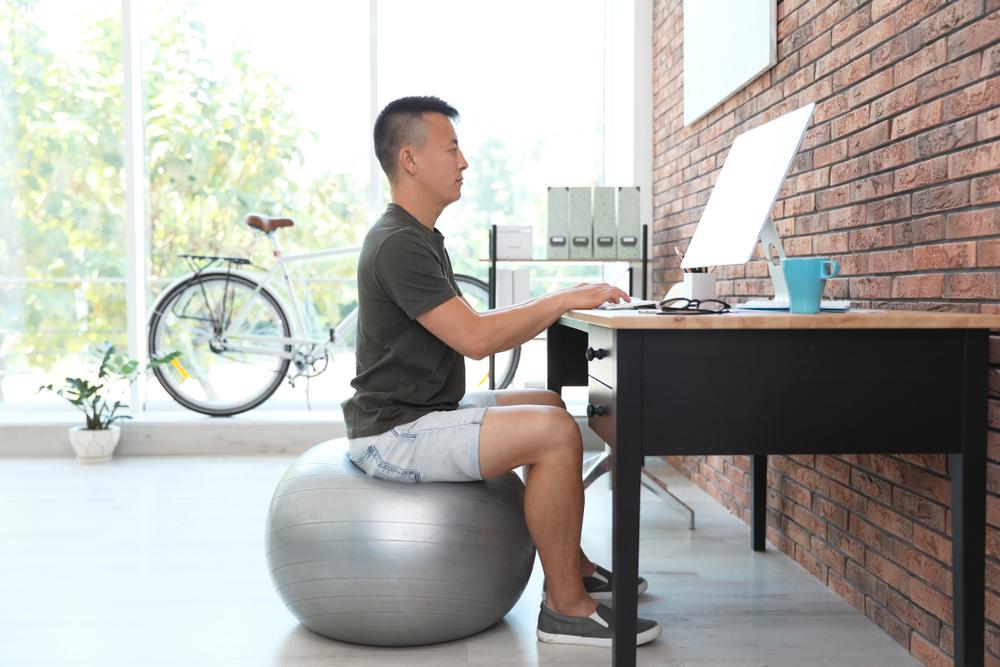Do Exercise Balls Make Good Office Chairs? | An Ergonomics Perspective

Photo Credit: New Africa / Shutterstock
Do Exercise Balls Make Good Office Chairs? Exploring the Ergonomics
In today’s modern work environment, the quest for improved comfort and productivity has led to innovative solutions in office furniture. One such solution that has gained attention is the use of exercise balls as office chairs. Proponents of this unconventional approach claim that exercise balls promote better posture, core engagement, and overall well-being. However, before you trade in your traditional office chair for a bouncy alternative, let’s dive into the ergonomic insights provided by experts to determine whether exercise balls truly make good office chairs.
The Hype Around Exercise Ball Chairs
Exercise ball chairs, also known as stability ball chairs, have gained popularity for their potential to alleviate common discomforts associated with prolonged sitting. These chairs are believed to promote active sitting, encouraging micro-movements that engage core muscles and prevent stiffness. Additionally, exercise ball chairs are thought to improve spinal alignment and reduce the risk of poor posture-related issues.
Ergonomics Experts Weigh In: Exercise Balls as Office Chairs
1. Spinal Alignment:
According to Dr. Sarah Johnson, a leading ergonomics specialist, exercise balls can indeed encourage better spinal alignment. When sitting on an exercise ball, the body’s natural tendency is to maintain a balanced posture, preventing slouching or hunching over the desk. However, Dr. Johnson advises caution, as maintaining an ideal posture on a ball requires continuous muscular effort, which can lead to fatigue over time.
2. Core Engagement:
Dr. Mark Roberts, a physical therapist with expertise in workplace ergonomics, emphasizes that exercise ball chairs can enhance core engagement. Sitting on a slightly unstable surface like a ball necessitates subtle adjustments in body position to maintain stability. This encourages the activation of core muscles, leading to improved muscle tone and reduced strain on the lower back.
3. Individual Considerations:
Ergonomics is not one-size-fits-all. Jane Williams, an ergonomics consultant, points out that the effectiveness of an exercise ball chair depends on an individual’s existing posture, fitness level, and specific ergonomic needs. Some individuals might find exercise balls uncomfortable or unsuitable for extended periods, while others may benefit greatly from the added movement and engagement.
Cautions and Considerations
While exercise ball chairs offer potential benefits, it’s essential to consider potential drawbacks as well:
1. Instability:
Exercise balls are inherently unstable, which means constant adjustments are required to stay balanced. This can lead to muscle fatigue and reduced focus, especially during tasks that demand intense concentration.
2. Lack of Support:
Traditional office chairs are designed with ergonomic features such as lumbar support and adjustable armrests. Exercise balls lack these features, potentially leading to discomfort or strain, particularly for those with existing musculoskeletal conditions.
3. Long-Term Viability:
The long-term sustainability of using an exercise ball as an office chair remains a topic of debate among experts. Prolonged sitting on a ball may lead to discomfort or even injury, especially if proper posture and balance are not maintained consistently.
Things to Remember
In the ever-evolving landscape of office ergonomics, exercise ball chairs have emerged as a unique alternative to traditional office chairs. While they offer the potential for improved posture, core engagement, and dynamic sitting, it’s important to approach this trend with a critical eye. Consultation with an ergonomics professional and a trial period can help determine if an exercise ball chair is a suitable addition to your workspace. Remember, the key to a comfortable and productive work environment lies in finding the right balance between movement and support.
Disclaimer: The information provided in this article is for educational purposes only and should not be considered a substitute for professional advice. Always consult with an ergonomics expert before making significant changes to your workspace setup.
